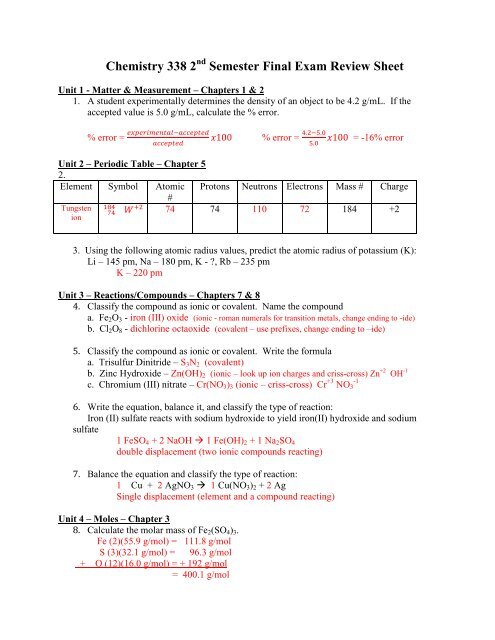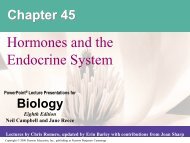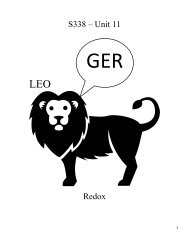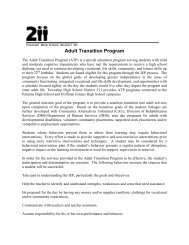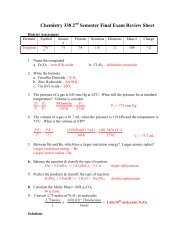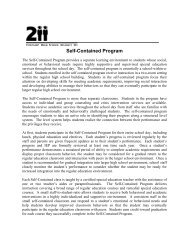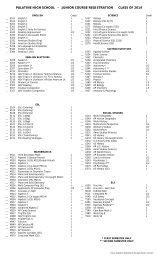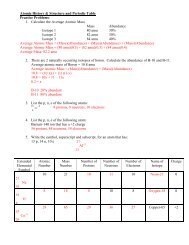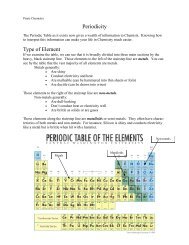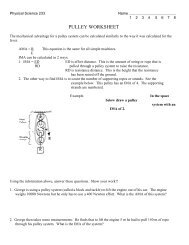Chemistry 338 2 Semester Final Exam Review Sheet
Chemistry 338 2 Semester Final Exam Review Sheet
Chemistry 338 2 Semester Final Exam Review Sheet
You also want an ePaper? Increase the reach of your titles
YUMPU automatically turns print PDFs into web optimized ePapers that Google loves.
<strong>Chemistry</strong> <strong>338</strong> 2 nd <strong>Semester</strong> <strong>Final</strong> <strong>Exam</strong> <strong>Review</strong> <strong>Sheet</strong><br />
Unit 1 - Matter & Measurement – Chapters 1 & 2<br />
1. A student experimentally determines the density of an object to be 4.2 g/mL. If the<br />
accepted value is 5.0 g/mL, calculate the % error.<br />
% error = % error = = -16% error<br />
Unit 2 – Periodic Table – Chapter 5<br />
2.<br />
Element Symbol Atomic<br />
#<br />
Protons Neutrons Electrons Mass # Charge<br />
74 74 110 72 184 +2<br />
Tungsten<br />
ion<br />
3. Using the following atomic radius values, predict the atomic radius of potassium (K):<br />
Li – 145 pm, Na – 180 pm, K - ?, Rb – 235 pm<br />
K – 220 pm<br />
Unit 3 – Reactions/Compounds – Chapters 7 & 8<br />
4. Classify the compound as ionic or covalent. Name the compound<br />
a. Fe 2 O 3 - iron (III) oxide (ionic - roman numerals for transition metals, change ending to -ide)<br />
b. Cl 2 O 8 - dichlorine octaoxide (covalent – use prefixes, change ending to –ide)<br />
5. Classify the compound as ionic or covalent. Write the formula<br />
a. Trisulfur Dinitride – S 3 N 2 (covalent)<br />
b. Zinc Hydroxide – Zn(OH) 2 (ionic – look up ion charges and criss-cross) Zn +2 OH -1<br />
c. Chromium (III) nitrate – Cr(NO 3 ) 3 (ionic – criss-cross) Cr +3 NO 3<br />
-1<br />
6. Write the equation, balance it, and classify the type of reaction:<br />
Iron (II) sulfate reacts with sodium hydroxide to yield iron(II) hydroxide and sodium<br />
sulfate<br />
1 FeSO 4 + 2 NaOH 1 Fe(OH) 2 + 1 Na 2 SO 4<br />
double displacement (two ionic compounds reacting)<br />
7. Balance the equation and classify the type of reaction:<br />
1 Cu + 2 AgNO 3 1 Cu(NO 3 ) 2 + 2 Ag<br />
Single displacement (element and a compound reacting)<br />
Unit 4 – Moles – Chapter 3<br />
8. Calculate the molar mass of Fe 2 (SO 4 ) 3 .<br />
Fe (2)(55.9 g/mol) = 111.8 g/mol<br />
S (3)(32.1 g/mol) = 96.3 g/mol<br />
+ O (12)(16.0 g/mol) = + 192 g/mol<br />
= 400.1 g/mol
9. How many molecules are in 36 g of Li 2 O<br />
x x = 7.27x10 23 molecules Li 2 O<br />
Unit 5 – Stoichiometry – Chapter 9<br />
10. Using the following balanced equation: 4 NH 3 + 5 O 2 4 NO + 6 H 2 O<br />
a. If 10 moles of H 2 O get produced, how many moles of NO will also be produced?<br />
x<br />
b. How many grams of O 2 are needed to react 824 g of NH 3 ?<br />
x x<br />
Unit 6 – Gases – Chapter 11<br />
11. The pressure of a gas is 843 mm Hg at 24 o C. What will the pressure be at 100 o C?<br />
Volume is held constant.<br />
P 1 = 843 mm Hg<br />
T 1 = 297 K (24 o C + 273)<br />
P 2 = ?<br />
T 2 = 373 K (100 o C + 273)<br />
P 2 = 1058.7 mm Hg<br />
12. The volume of a gas is 81.7 mL when the pressure is 119 kPa. What is the volume when<br />
the pressure is changed to 500 kPa?<br />
P 1 = 119 kPa<br />
V 1 = 81.7 mL<br />
P 2 = 500 kPa<br />
V 2 = ?<br />
P 1 V 1 = P 2 V 2 (119 kPa)(81.7 mL) = (500 kPa)(V 2 ) V 2 = 19.4 mL<br />
Unit 7 - Solutions – Chapters 12-13<br />
13. What precipitate forms when you combine CaCl 2 and Na 2 CO 3 ?<br />
CaCl 2 + Na 2 CO 3 CaCO 3 (s) + 2 NaCl (aq)<br />
CaCO 3 (s)<br />
14. A solution is made by dissolving 30 g of NaCl into water creating a solution with a total<br />
volume of 2 L. What is the molarity?<br />
30gNaCl<br />
1moleNaCl<br />
x 0.513molNaC<br />
l<br />
1 58.5gNaCl
0.513molNaCl<br />
Molarity 0.256M<br />
2LSolution<br />
15. A solution is made by dissolving 2 moles of NaCl into 4 kg of water. What is the<br />
molality?<br />
2molNaCl<br />
molality 0.5m<br />
4kgH 2O<br />
16. A student has 200 mL of a 3 M HCl solution. The student adds water until the total<br />
volume of the solution becomes 600 mL. What is the new molarity of the HCl solution?<br />
M 1 V 1 = M 2 V 2<br />
(3M)(200mL) = (M 2 )(600mL)<br />
M 2 = 1.0 M HCl<br />
17. What is the boiling point elevation of a 2 m NaCl solution? (K b H 2 O = 0.52 o C/m)<br />
ΔT b = K b x m x i<br />
ΔT b = (0.52 C / m) x(2 m) x(2) 2.08 C<br />
Unit 8 - Equilibrium – Chapter 18<br />
18. Write the equilibrium expression for the following equation:<br />
2 A (g) + 3 B (g) ↔ 2 C (g)<br />
K = __[C] 2 __<br />
[A] 2 [B] 3<br />
19. In the equation above, which direction does the equilibrium shift if more A is added?<br />
Shift to the right<br />
20. What happens to the concentration of C when the equilibrium shifts right?<br />
Concentration of C increases<br />
21. The K sp of BaCO 3 is 2.58x10 -9 . What is the concentration of Ba +2 at equilibrium? What<br />
-2<br />
is the concentration of CO 3 at equilibrium?<br />
1BaCO 3 (s) ↔ 1 Ba +2 (aq) + 1 CO -2 3 (aq)<br />
x<br />
x<br />
K sp = [Ba +2 ][ CO 3 -2 ]<br />
2.58x10 -9 = [x][x]<br />
2.58x10 -9 = x 2<br />
X = 5.1x10 -5 M Ba +2 , CO 3<br />
-2
Unit 9 - Acids and Bases _Chapters 14-15 & 18<br />
22. Calculate the pH of the following and classify acid/base/neutral:<br />
a. 1.0x10 -2 M = [H + ] b 3.7 x 10 -5 M = [OH - ]<br />
pH = 2 - Acid<br />
pH = 9.57 – base<br />
23. A 0.11 M weak acid has a [H + ] = 0.0004 M at equilibrium. What is the Ka of the acid?<br />
1 HA (aq) ↔ 1 H + (aq) + 1 A - (aq)<br />
I 0.11 0 0<br />
C -0.0004 +0.0004 +0.0004<br />
E 0.1096 0.0004 0.0004<br />
Ka = [H+][A-] Ka = [0.0004][0.0004] Ka = 1.46x10 -6<br />
[HA] [0.1096]<br />
24. How many mL of a10 M HCl are needed to neutralize 380 mL of a 7 M NaOH?<br />
1 HCl + 1 NaOH 1 NaCl + 1 H 2 O<br />
380 mL _ NaOH 1 L _ NaOH 7 mol _ NaOH 1 mol _ HCl 1 L _ HCl 1000 mL _ HCl<br />
x x x x x<br />
1 1000 mL _ NaOH 1 L _ NaOH 1 mol _ NaOH 10 mol _ HCl 1 L _ HCl<br />
= 266 mL HCl<br />
<br />
25. In the following reaction, identify the acid and base and its conjugate pairs (Bronsted-<br />
Lowry): H 2 O + NH 3 → NH 4 + + OH -<br />
A B CA CB<br />
26. Name the following acids:<br />
a) H 2 S – hydrosulfuric acid<br />
b) HNO 2 – nitrous acid<br />
c) HClO 3 – chloric acid<br />
27. What is the salt that forms when Sr(OH) 2 reacts with HNO 3 ?<br />
Sr(OH) 2 + 2 HNO 3 Sr(NO 3 ) 2 + 2 H 2 O<br />
Sr(NO 3 ) 2<br />
Unit 10 - Electrons – Chapter 4, 6<br />
28. Draw the lewis dot structure, state the shape, and hybridization<br />
a. CH 4 - tetrahedral, sp 3
. NH 3 - pyramidal, sp 3<br />
29. Using electronegativity values, determine if the compound has nonpolar, polar, or ionic<br />
bonds:<br />
a. KF<br />
Electronegativity F – 4.0<br />
Electronegativity K – 0.8<br />
4.0 – 0.8 = 3.2 electronegativity difference ionic bond<br />
b. SO 2<br />
Electronegativity S – 2.5<br />
Electronegativity O – 3.5<br />
3.5 – 2.5 = 1.0 electronegativity difference polar covalent bond<br />
c. Cl 2<br />
Electronegativity Cl – 3.0<br />
Electronegativity Cl – 3.0<br />
3.0– 3.0 = 0 electronegativity difference nonpolar covalent bond<br />
30. Rank the following compounds from lowest to highest melting point:<br />
KF, CH 4 , C 3 H 8 , H 2 O<br />
KF – ionic bonds, ionic forces<br />
CH 4 – nonpolar bonds, London forces<br />
C 3 H 8 – nonpolar bonds, London forces (stronger London forces than CH 4 due to bigger<br />
mass)<br />
H 2 O – polar bonds, polar molecule (no symmetry due to bent shape), hydrogen bonds<br />
CH 4 < C 3 H 8 < H 2 O < KF<br />
31. Write the electron configuration (the long and short way) for the following elements and<br />
state the number of unpaired electrons:<br />
a. Silicon (Si)<br />
1s 2 2s 2 2p 6 3s 2 3p 2<br />
[Ne] 3s 2 3p 2<br />
2unpaired e -
. Palladium (Pd)<br />
1s 2 2s 2 2p 6 3s 2 3p 6 4s 2 3d 10 4p 6 5s 2 4d 8<br />
[Kr] 5s 2 4d 8<br />
2unpaired e -<br />
32. Calculate the wavelength (λ) of light which gives off 2.87x10 -19 J of energy<br />
E = hν 2.87x10 -19 J = (6.6262x10 -34 Js)( ν ) ν = 4.33x10 14 s -1<br />
c = λν 3x10 8 m/s = ( λ ) (4.33x10 14 s -1 ) λ = 6.93x10 -7 m<br />
Unit 11 - Redox – Chapters 19-20<br />
33. Balance the following equations using redox and identify the element being oxidized,<br />
reduced, the oxidizing agent, and the reducing agent.<br />
0 +1+6-2 +4-2 +4-2 +1 -2<br />
a. C + H 2 SO 4 CO 2 + SO 2 + H 2 O<br />
0 +4<br />
(C → CO 2 + 4e - ) carbon is oxidized, carbon is the reducing agent<br />
+6 +4<br />
(2e - + H 2 SO 4 → SO 2 )2 sulfur is reduced, sulfur is the oxidizing agent<br />
C → CO 2 + 4e -<br />
4e - + 2H 2 SO 4 → 2SO 2<br />
C + 2 H 2 SO 4 CO 2 + 2 SO 2 + 2 H 2 O<br />
+1 +7 -2 +1 -1 +2 -1 0 +1 -2 +1 -1<br />
b. KMnO 4 + HCl MnCl 2 + Cl 2 + H 2 O + KCl<br />
-1 0<br />
(2 HCl → Cl 2 + 2e - ) 5 chlorine is oxidized, chlorine is the reducing agent<br />
+7 +2<br />
(5e - + KMnO 4 → MnCl 2 )2 manganese is reduced, manganese is the oxidizing agent<br />
10 HCl → 5 Cl 2 + 10 e -<br />
10 e - + 2 KMnO 4 → 2 MnCl 2<br />
2 KMnO 4 + 10 HCl 2 MnCl 2 + 5 Cl 2 + H 2 O + KCl<br />
34. Calculate the voltage of the following voltaic cell, label the anode, cathode, and the<br />
direction of the electron flow for the following voltaic cell:<br />
Cu/Cu +2 and Al/Al +3<br />
Oxidation – Anode Al Al +3 + 3e - 1.66 V<br />
Reduction – Cathode Cu +2 + 2e - Cu<br />
0.34 V<br />
2 Al + 3 Cu +2 2 Al +3 + 3 Cu 2.00 V produced<br />
Electron flow from the Al to Cu (anode to cathode)
Unit 12 - Thermochem –Chapter 16<br />
Specific Heats: Cu ( C = 0.381 J/g o C), Al ( C = 0.907 J/g o C), water (C = 4.18 J/g o C)<br />
Substance Heat of Fusion in cal/g Heat of Vaporization in cal/g<br />
H 2 O 80 540<br />
Cu 49 1150<br />
35. How much heat is needed to raise 100 g of Cu from 10 o C to 80 o C?<br />
q = mcT<br />
q = (100 g)( 0.381 J/g o C)(70 o C)<br />
q = 2667 J<br />
36. How much heat is absorbed when 15g water boils?<br />
Liquid gas Vaporization<br />
q = mass x heat of vaporization<br />
q = (15 g) x (540 cal/g)<br />
q = 8100 cal<br />
37. How much heat is released when 8g of water at 99 o C is cooled to 70 o C?<br />
q = mcT<br />
q = (8g)( 4.18 J/g o C)(-29 o C)<br />
q = -970 J or -232 cal


